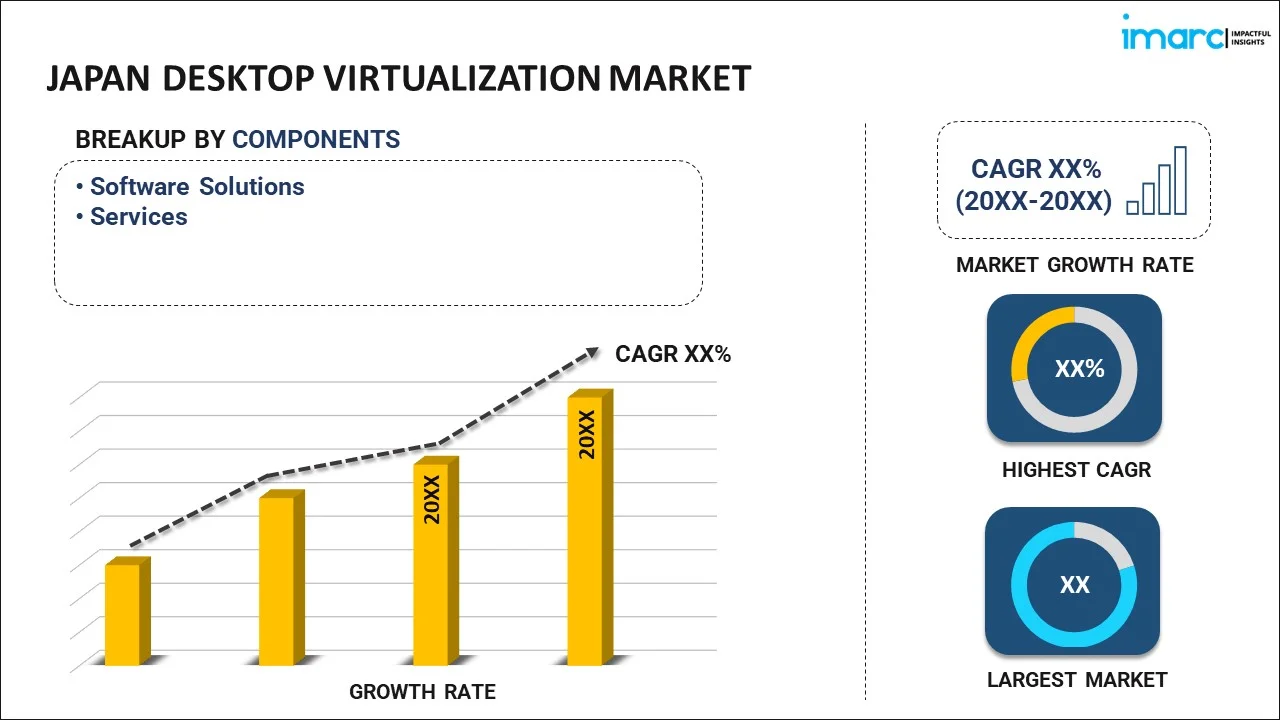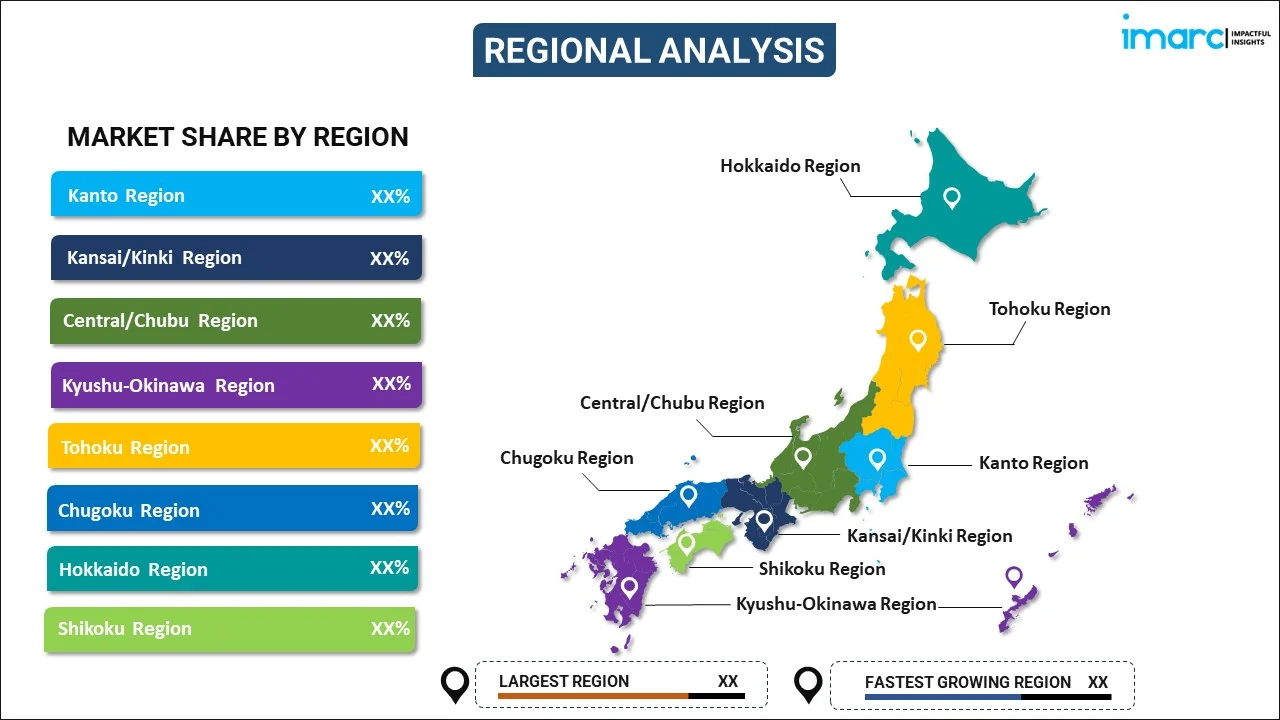
Japan Desktop Virtualization Market Report by Component (Software Solutions, Services), Type (Virtual Desktop Infrastructure (VDI), Desktop-as-a-Service (Daas), Remote Desktop Services (RDS)), Organization Size (Large Enterprises, Small and Medium-sized Enterprises), Industry Vertical (BFSI, IT and Telecom, Education, Healthcare, Government, Energy and Utilities, Manufacturing, and Others), and Region 2026-2034
Market Overview:
Japan desktop virtualization market size reached USD 901.7 Million in 2025. Looking forward, IMARC Group expects the market to reach USD 1,993.5 Million by 2034, exhibiting a growth rate (CAGR) of 9.22% during 2026-2034. The emerging workforce trends, such as remote work, the gig economy, and the need for flexible work arrangements, which have increased the demand for virtual desktop solutions, are primarily driving the market.
|
Report Attribute
|
Key Statistics
|
|---|---|
|
Base Year
|
2025
|
|
Forecast Years
|
2026-2034
|
|
Historical Years
|
2020-2025
|
| Market Size in 2025 | USD 901.7 Million |
| Market Forecast in 2034 | USD 1,993.5 Million |
| Market Growth Rate 2026-2034 | 9.22% |
Desktop virtualization is a transformative technology that has revolutionized the way businesses and individuals interact with their computers. It allows users to run multiple virtual desktops on a single physical machine, decoupling the operating system and applications from the underlying hardware. This means that users can access their desktop environment from anywhere, using any device with an internet connection, making it a crucial tool for remote work and mobility. One of the key benefits of desktop virtualization is enhanced security. By centralizing data and applications in a data center or cloud environment, organizations can better protect sensitive information and mitigate the risks of data breaches. It also simplifies software deployment and management, as updates and patches can be applied uniformly across all virtual desktops. Moreover, desktop virtualization promotes resource efficiency, as it allows for the consolidation of hardware resources and reduces energy consumption. It is a cost-effective solution for organizations looking to streamline their IT infrastructure while providing a more flexible and productive computing environment for their workforce.
Japan Desktop Virtualization Market Trends:
The desktop virtualization market in Japan is experiencing robust growth, primarily driven by several key factors. Firstly, the increasing demand for cost-efficient IT solutions has spurred organizations to adopt desktop virtualization technologies. Additionally, the rapid proliferation of remote work and the need for secure and accessible work environments have fueled the adoption of desktop virtualization solutions. Moreover, the ever-evolving landscape of technology, characterized by the emergence of new devices and operating systems, has led to a need for seamless compatibility and scalability. Desktop virtualization addresses these challenges by providing a standardized and adaptable environment. Furthermore, the growing emphasis on data security and compliance requirements has made desktop virtualization an attractive option for businesses looking to safeguard their sensitive information. Furthermore, environmental sustainability is a driving force in the desktop virtualization market. Organizations are increasingly focused on reducing their carbon footprint, and virtualization technologies enable the consolidation of hardware, leading to energy savings and reduced e-waste. Lastly, the ongoing advancements in cloud computing and the accessibility of high-speed internet, which offer flexibility and agility for businesses of all sizes, are expected to drive the desktop virtualization market in Japan.
Japan Desktop Virtualization Market Segmentation:
IMARC Group provides an analysis of the key trends in each segment of the market, along with forecasts at the country level for 2026-2034. Our report has categorized the market based on component, type, organization size, and industry vertical.
Component Insights:

- Software Solutions
- Services
The report has provided a detailed breakup and analysis of the market based on the component. This includes software solutions and services.
Type Insights:
- Virtual Desktop Infrastructure (VDI)
- Desktop-as-a-Service (Daas)
- Remote Desktop Services (RDS)
A detailed breakup and analysis of the market based on the type have also been provided in the report. This includes virtual desktop infrastructure (VDI), desktop-as-a-service (Daas), and remote desktop services (RDS).
Organization Size Insights:
- Large Enterprises
- Small and Medium-sized Enterprises
The report has provided a detailed breakup and analysis of the market based on the organization size. This includes large enterprises and small and medium-sized enterprises.
Industry Vertical Insights:
- BFSI
- IT and Telecom
- Education
- Healthcare
- Government
- Energy and Utilities
- Manufacturing
- Others
A detailed breakup and analysis of the market based on the industry vertical have also been provided in the report. This includes BFSI, IT and telecom, education, healthcare, government, energy and utilities, manufacturing, and others.
Regional Insights:

- Kanto Region
- Kansai/Kinki Region
- Central/ Chubu Region
- Kyushu-Okinawa Region
- Tohoku Region
- Chugoku Region
- Hokkaido Region
- Shikoku Region
The report has also provided a comprehensive analysis of all the major regional markets, which include Kanto Region, Kansai/Kinki Region, Central/ Chubu Region, Kyushu-Okinawa Region, Tohoku Region, Chugoku Region, Hokkaido Region, and Shikoku Region.
Competitive Landscape:
The market research report has also provided a comprehensive analysis of the competitive landscape. Competitive analysis such as market structure, key player positioning, top winning strategies, competitive dashboard, and company evaluation quadrant has been covered in the report. Also, detailed profiles of all major companies have been provided.
Japan Desktop Virtualization Market News:
- April 2025: NEC announced that it improved user experience by deploying 90,000 Azure ‘Virtual Desktop’ instances in Japan. People could experience a seamless and adaptable engagement, while NEC supported work style transformation in the country by offering services to clients informed by insights obtained from this initiative.
Japan Desktop Virtualization Market Report Coverage:
| Report Features | Details |
|---|---|
| Base Year of the Analysis | 2025 |
| Historical Period | 2020-2025 |
| Forecast Period | 2026-2034 |
| Units | Million USD |
| Scope of the Report | Exploration of Historical Trends and Market Outlook, Industry Catalysts and Challenges, Segment-Wise Historical and Future Market Assessment:
|
| Components Covered | Software Solutions, Services |
| Types Covered | Virtual Desktop Infrastructure (VDI), Desktop-as-a-Service (Daas), Remote Desktop Services (RDS) |
| Organization Sizes Covered | Large Enterprises, Small and Medium-sized Enterprises |
| Industry Verticals Covered | BFSI, IT and Telecom, Education, Healthcare, Government, Energy and Utilities, Manufacturing, Others |
| Regions Covered | Kanto Region, Kansai/Kinki Region, Central/ Chubu Region, Kyushu-Okinawa Region, Tohoku Region, Chugoku Region, Hokkaido Region, Shikoku Region |
| Customization Scope | 10% Free Customization |
| Post-Sale Analyst Support | 10-12 Weeks |
| Delivery Format | PDF and Excel through Email (We can also provide the editable version of the report in PPT/Word format on special request) |
Key Benefits for Stakeholders:
- IMARC’s industry report offers a comprehensive quantitative analysis of various market segments, historical and current market trends, market forecasts, and dynamics of the Japan desktop virtualization market from 2020-2034.
- The research report provides the latest information on the market drivers, challenges, and opportunities in the Japan desktop virtualization market.
- Porter's five forces analysis assist stakeholders in assessing the impact of new entrants, competitive rivalry, supplier power, buyer power, and the threat of substitution. It helps stakeholders to analyze the level of competition within the Japan desktop virtualization industry and its attractiveness.
- Competitive landscape allows stakeholders to understand their competitive environment and provides an insight into the current positions of key players in the market.
Key Questions Answered in This Report
The desktop virtualization market in Japan was valued at USD 901.7 Million in 2025.
The Japan desktop virtualization market is projected to exhibit a CAGR of 9.22% during 2026-2034, reaching a value of USD 1,993.5 Million by 2034.
The growing demand for cost-effective information technology (IT) management is positively influencing the market, as desktop virtualization reduces hardware costs, streamlines maintenance, and extends device lifecycles. Additionally, the rise of bring your own device (BYOD) culture in the workplace is encouraging companies to adopt virtual desktops to ensure secure access across multiple devices. Moreover, technological advancements and increasing awareness about the benefits of virtualization are driving the market expansion in Japan.
Need more help?
- Speak to our experienced analysts for insights on the current market scenarios.
- Include additional segments and countries to customize the report as per your requirement.
- Gain an unparalleled competitive advantage in your domain by understanding how to utilize the report and positively impacting your operations and revenue.
- For further assistance, please connect with our analysts.
 Request Customization
Request Customization
 Speak to an Analyst
Speak to an Analyst
 Request Brochure
Request Brochure
 Inquire Before Buying
Inquire Before Buying




.webp)




.webp)












